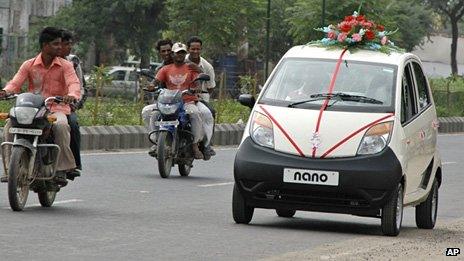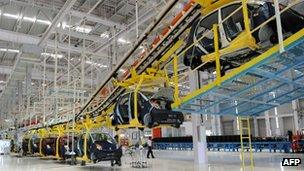A bumpy ride for the world's cheapest car
- Published

Tata Motors had racked up more than 200,000 fully paid orders initially
For a car that received every possible accolade from all over the world at a rock-star reception in January 2008 at the Delhi Auto Expo, who could have imagined the bumpy ride the Tata Nano has had ever since?
But then, no-one, not even Tata, could have imagined the incredibly challenging gestation period the Nano went through from motor show to showroom.
Undoubtedly the biggest setback for the Nano was the traumatic factory relocation of 1,000 miles (1,600km) across the country, from Singur, West Bengal, to Sanand in Gujarat, which delayed the launch by over a year.
When the car was finally launched and bookings were thrown open, the Nano frenzy was kick-started again.
The company racked up more than 200,000 fully paid orders, or more than two years of production from the limited and makeshift capacities in Tata's truck and car plants.
The company could make what it sold but just months before the Sanand plant was ready for full scale production, the highly publicised incidents of the Nano catching fire battered the car's reputation. The timing couldn't have been worse.
Customer resistance
There were several other issues that conspired to turn chairman Ratan Tata's dream sour.
Most of these revolved around inept marketing rather than the product itself. The first round of bookings for the Nano was a lottery for many and hence it was hard to gauge the true demand for the car.
The booking system alienated a lot of genuine buyers and it didn't help when sales failed to reopen for more than a year because of production delays.
Some advertising experts say that Tata Motors became complacent after the huge bookings it received and didn't implement a comprehensive advertising strategy to keep the Nano brand pumped up, relying on the hype created by unprecedented media coverage. Ironically, this was the Nano's undoing.
While industry analysts, experts and the media lauded the Nano as the world's cheapest car and praised Tata for its frugal engineering and cost structure, customers didn't take kindly to this tag.
In fact, the biggest reason why many potential Nano buyers turned up their noses and walked away is because they did not want to be seen in the world's cheapest car.
Even at the bottom of the pyramid, a car is highly aspirational and image is crucial. To be seen in the world's cheapest car gave the message that you couldn't afford anything else.
To make things worse, Tata Motors jacked up the price of the Nano by around 10% at the beginning of this year, which in effect made it a 200,000 rupee ($3,900; £2,470) car (for the top-end model). But the perception was that it still cost around 100,000 rupees.
The 2012 Nano
With price becoming the overriding reason to buy (or not to buy) a Nano, what people missed (including some in the Tata HQ) were the other good reasons to own this car.

Production was shifted to Sanand but has not been without problems
The Nano is a very clever car and does the job it was set out to and, in fact, Nano owners (including myself) are by and large a pretty happy lot.
They love the car for its cheerful looks, low running costs, ability to pack in an extended family and tackle the worst of roads. The tight turning circle and high seating position is ideal for congested cities and it's easy to park too.
However, for customers to bite, the Nano has to be seen as the car you want to buy rather than the one you need to, and that's what the company is now working on.
Rather than small towns and rural areas, Tata will also focus on the big cities where aspiration of the Nano is best built.
It's college kids rather than a family on a bike Tata needs to chase. The Nano makes good sense as the second or even third car in a family rather than the first (around 50% of first time car buyers don't even have a licence!) and the connection with Nano owners has to be more emotional than practical.
This is the direction Tata Motors has now taken with the 2012 Nano that's just been launched. This upgraded version irons out the bugs of the earlier Nano and at the same time feels a lot more upmarket.
Customers complained about the heavy steering but it's now modified and requires less effort. The engine gets more power and it feels more refined. Fuel efficiency has improved too.
The new car also gets a bright range of colours and spruced up interiors and this has injected genuine appeal into the car. The initial response has been very positive.
Though sales figures are nowhere close to the all-time high of 10,012 units in April 2011 there has been a sharp spike in demand for the 2012 Nano, which is very encouraging, especially in a market that's going through a slump.
But will the Nano eventually take its due place at the top of the sales charts? There's no doubting this little car's potential, even if the core of the market has moved upwards to more substantial hatchbacks.
The Nano has no competition at its price point and is unlikely to have a direct rival in the near future. With further upgrades and more engine options coming out in due course, it's only a matter of time for the Nano to click.
Besides, there's a steely determination within the company, led by Ratan Tata himself to make sure that, before he retires, his brainchild is nothing less than a success.
After Ratan proved critics completely wrong with his first car, the Indica, more than a decade ago, I wouldn't bet against it.
But for the Nano to become a hot-seller, it first has to get cool.
Hormazd Sorabjee is the editor of Autocar India. He was one of the first journalists to test drive the Nano when it launched in 2009.
- Published18 April 2011